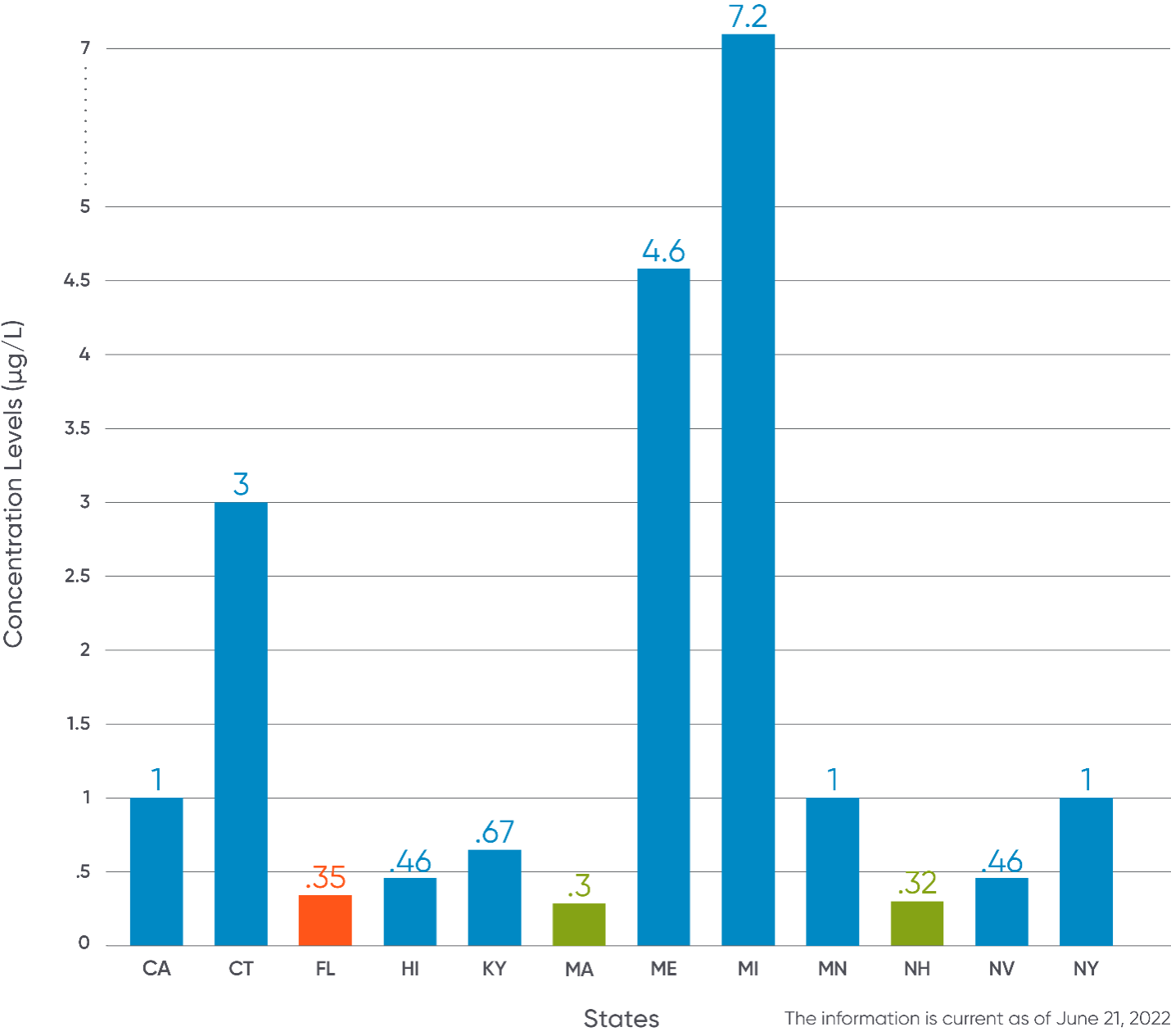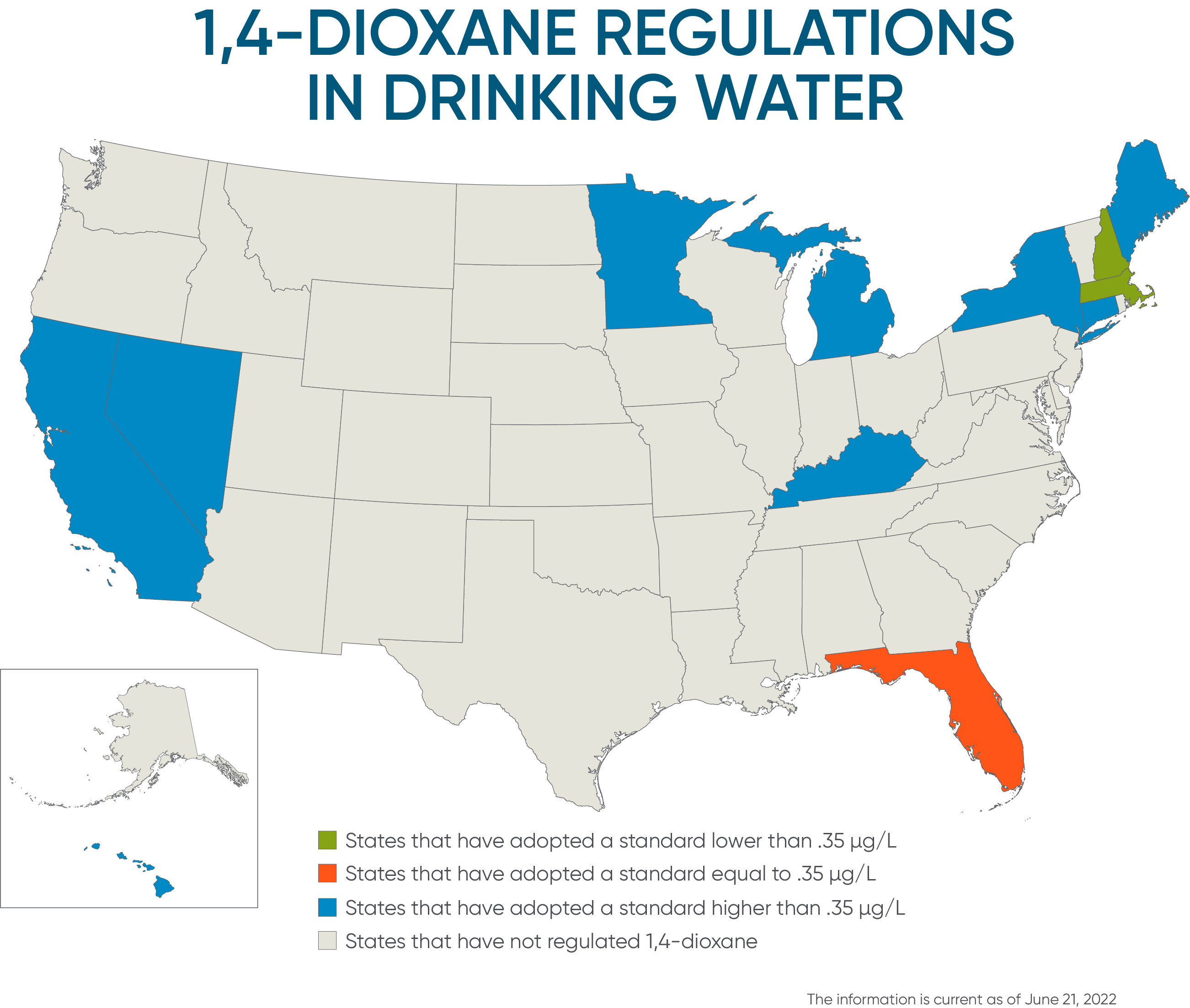Insights
State-by-State Regulation of 1,4-Dioxane in Drinking Water
Jun 22, 2022As illustrated by the May 11, 2022, press release for the Industrial Excess Landfill Superfund Site in Uniontown, Ohio, the U.S. Environmental Protection Agency (“EPA”) and state environmental agencies have begun directing potentially responsible parties to conduct investigations to address the presence of 1,4-dioxane in drinking water and groundwater. Notably, some of these investigations are conducted at previously closed sites at which the chemical had not been initially identified as a contaminant of concern.
To protect the environment and avoid liability, any business in industries that use or produce this chemical must determine whether it needs to modify its operations to reduce or eliminate 1,4-dioxane.
In the absence of an enforceable federal drinking water standard for 1,4-dioxane, many states have started regulating 1,4-dioxane in drinking water. The result is a patchwork of regulations and standards. This client alert surveys the maximum contaminant levels (“MCLs”), remediation, guidance, and notification levels for 1,4-dioxane in drinking water across the United States.
I. EPA Health Advisory
EPA has stated that a concentration of 35 micrograms per liter (µg/L) of 1,4-dioxane (indicated by EPA as .035 milligrams per liter) should not be exceeded in drinking water. According to EPA, this number corresponds to an estimated incremental lifetime cancer risk to an exposed individual of 1 in 10,000.
EPA's Health Advisory is non-enforceable, but is intended to provide technical information to state agencies and other public health officials regarding the health effects of the chemical. The decision to promulgate a federal MCL for the chemical will turn on EPA’s evaluation of the three statutory criteria for regulation: (1) the adverse health effects of those people affected; (2) a level of public health concern; and (3) providing a meaningful opportunity for health risk reduction.
II. State Regulations
In the absence of a federal MCL for 1,4-dioxane, the regulatory landscape for drinking water consists of an array of widely-varying state-promulgated standards and regulations. For example, the smallest allowable concentration is 0.3 µg/L (Massachusetts), and the largest value is 7.2 µg/L (Michigan).

The map and chart are current as of June 21, 2022.
Virginia has enacted legislation to establish MCLs for 1,4-dioxane for drinking water, so implementing regulations in this jurisdiction may be forthcoming. New Jersey is in the process of enacting an MCL for 1,4-dioxane for drinking water. There are a few states (e.g., Ohio) that have included 1,4-dioxane in their risk-derived generic standards. These values are usually advisory and can be used by state agencies when ordering parties to remediate sites.

|
|
Participating States |
Concentration Level |
Type of Regulation |
Adoption Status |
|
|
Massachusetts |
.3 µg/L |
Advisory |
Massachusetts Department of Environmental Protection 1,4-Dioxane Information |
|
|
New Hampshire |
.32 µg/L |
Clean Up |
New Hampshire Code of Administrative Rules Ch. Env-Or-600 and New Hampshire Department of Environmental Services 1,4-Dioxane Health Information Summary |
|
|
Florida |
.35 µg/L |
Advisory |
Florida Department of Health: Private Drinking Water Wells and Florida Department of Health: 1,4-Dioxane Information |
|
|
Hawaii |
.46 µg/L |
Advisory |
Environmental Action Levels (See Table D-3a) |
|
|
Nevada |
.46 µg/L |
Guidance |
|
|
|
Kentucky |
.67 µg/L |
Advisory |
|
|
|
California |
1 µg/L 35 µg/L (Response Level) Removal from Service |
Notification
|
|
|
|
Minnesota |
1 µg/L |
Guidance |
Minnesota Department of Health Human Health-Based Water Table and Minnesota Department of Health 1,4-Dioxane Information |
|
|
New York |
1 µg/L (Stated as 1 ppb) |
MCL |
|
|
|
Connecticut |
3 µg/L |
Clean Up |
Connecticut Department of Public Health Fact Sheet and Connecticut Department of Energy and Environmental Protection 11,4-Dioxane Information |
|
|
Maine |
4.6 µg/L |
Advisory |
Maine Department of Environmental Protection Remedial Action Guidelines (See Table 7) |
|
|
Michigan |
7.2 µg/L (Stated as 7.2 ppb) |
Clean Up |
Michigan Department of Environmental Quality Environmental Contamination Response Activity |
States with No 1,4-dioxane Drinking Water Regulations or Enforceable Guidance (as of the date of publication):
Alabama, Alaska, Arizona, Arkansas, Colorado, Delaware, Georgia, Idaho, Illinois, Indiana, Iowa, Kansas, Louisiana, Maryland, Mississippi, Missouri, Montana, Nebraska, New Jersey, New Mexico, North Carolina, North Dakota, Ohio, Oklahoma, Oregon, Pennsylvania, Rhode Island, South Carolina, South Dakota, Tennessee, Texas, Utah, Vermont, Virginia, Washington, West Virginia, Wisconsin, and Wyoming
Key:
|
Notification |
A corporate representative may have to inform an appropriate state official that a drinking water concentration in a water source owned or operated by the corporation (public well, supply tank, etc.) is above the limit. A water supply system also may have to inform its customers if there are samples that exceed the 1,4-dioxane values. |
|
Advisory |
The state establishes recommended concentration limits for 1,4-dioxane, but no notification or other action is required if concentrations exceed the recommended limits. |
|
MCL |
MCLs establish the maximum amount of 1,4-dioxane that can be present in drinking water. Treatment facilities that supply drinking water must ensure that these limits are met by treating and filtering the drinking water, and also by limiting the discharge of 1,4-dioxane through permits. |
|
Clean Up |
Investigation and remediation is usually required when concentration levels exceed the threshold. Clean up standards are usually expressed by values that identify specific clean up criteria. |
III. How Do These Limits Impact Businesses?
MCLs set the maximum concentration of a given contaminant that can be present in drinking water. Publicly owned treatment works (“POTWs”) and drinking water systems are ultimately responsible for meeting the applicable MCLs and are required to ensure that drinking water distributed to the public meets these limits. In order to do that, POTWs and state agencies often include discharge limits in the permits of upstream dischargers to the POTW or other drinking water systems to ensure that the effluent the treatment facility receives can be adequately filtered and treated to comply with the MCLs.
Businesses that currently or historically have used 1,4-dioxane, or have reason to believe that the chemical may be present in their process wastewater effluent, should evaluate the following considerations:
- Whether their wastewater discharges, following treatment by the POTW or other treatment facilities, are eventually released to sources that are used for drinking water;
- Whether their discharge contains any of the 1,4-dioxane that are regulated in their jurisdiction; and
- Whether they are likely to be subject to permit conditions limiting the allowable concentration of 1,4-dioxane in their wastewater discharges.
This assessment will allow a businesses to determine whether it needs to modify its operations to reduce or eliminate 1,4-dioxane from its waste stream to achieve compliance with an existing standard, or in anticipation of likely future permit conditions.
IV. Conclusion
The regulation of 1,4-dioxane in drinking water will continue over the next several years as additional research is conducted on potential health impacts, and as regulators at both the federal and state levels develop a deeper understanding of the prevalence of 1,4-dioxane in drinking water.
If you have any questions regarding 1,4-dioxane, please contact Phil Karmel (212-541-2311), John Kindschuh (314-259-2313), or Erin Brooks (314-259-2393).
Related Practice Areas
-
PFAS Team
-
Environment





